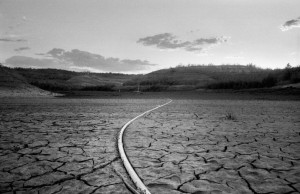Catching up the other day, I ran across Where the River Runs Dry by David Owen for the New Yorker on May 25. It’s a great piece of reporting and writing about the Colorado River, from its headwaters on the Western slope of the Rocky Mountains in Colorado to its delta in Mexico, south of Yuma, AZ.
You really need to read this article. Here’s some of what I learned:
- The river and the basin, underground, are drying up. Lake Mead’s water volume has fallen by 60% since 1998. GRACE (Gravity Recovery and Climate Experiment), a very cool two-satellite NASA mission, has determined that the river basin lost 50 cubic kilometers—900 hundred square miles, to a depth of 30 miles—of groundwater.
- The river serves 36 million people. But, and this is important, agriculture uses about 80% of Colorado River water. So, while wasting water is mostly bad—more on the “mostly” below—individuals can only make a comparatively small difference.
- The agricultural uses are focused heavily on California’s Imperial Valley. And why are farmers growing crops where water really matters? Because they can grow crops efficiently. Mr. Owen reports on farmer Lawrence Cox and his spreadsheet, who notes the fact that “if we do get rain it disrupts our normal activities.” Dependable weather allows Mr. Cox and his fellow farmers to schedule crops as if they’re operating a factory. Highly efficient farms give us cheaper food, but we’re draining our future to keep our salads cheap.
- “Reducing waste seems like an obvious solution to overuse, but it can actually make the problem worse.” Owen relies on Bradley Udall, a scientist at the Colorado State University Colorado Water Institute, who distinguishes between consumptive and non-consumptive uses. More efficient farming practices increased the consumptive share of the water which gets used, leaving less water to for recharge and other users. Very counter-intuitive thinking. (By the way, Mr. Owen notes that Bradley Udall’s family “has been prominent in conservation and in regional and national politics for decades.” Understatement, for sure!)
- More efficient farming in the Imperial Valley, coupled with repairs to the All-American Canal, have reduced runoff from the lower part of the valley. This fact explains, mostly, why the Salton Sea is drying up. (For more about the Salton Sea, read The Dying Sea by Dana Goodyear for the New Yorker on May 4. Another fine piece of journalism!) The canal situation also accounts for the loss of some Mexican wetlands and less water for Mexican farmers.
- The Central Arizona Project brings Colorado River water to Phoenix and Tucson. The federal government paid for the project, and repayment is required. Farmers buying CAP water was the plan; however, the water is too expensive, so they’re not buying. In lieu of letting water not purchased go unused—which would let California have the water—Arizona municipalities buy the water and sell it cheaply to the farmers. Per Grady Gammadge, Jr., a Phoenix attorney and former chair of the CAP Board of Directors, “the cities were willing to do that because ‘keeping water away from California is one of our fundamental principles.’”
I’ve known about Colorado River issues for most of my life, although Mr. Owen’s piece taught me so much I did not know. Most significant are the number of major unintended consequences associated with river policies. And there’s so little ability to deal with them. The basin reaches seven states and Mexico, and the states don’t rank high on the “plays well with others” list. Hundreds of billions of dollars are invested in communities and agricultural, all of it highly dependent on a water source that we can’t manage very well. Not good. Not good at all!

